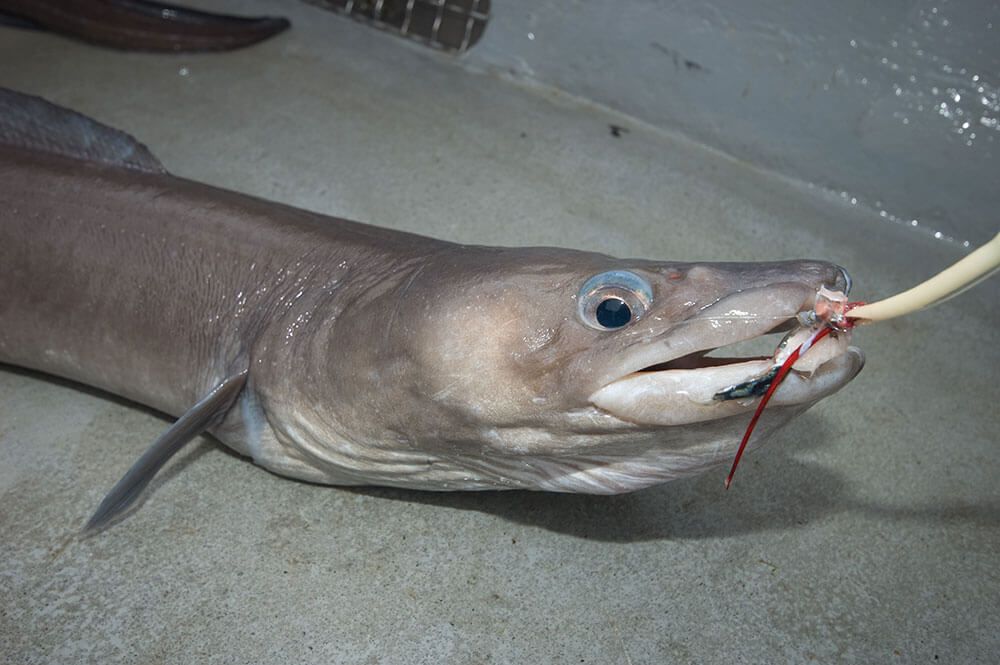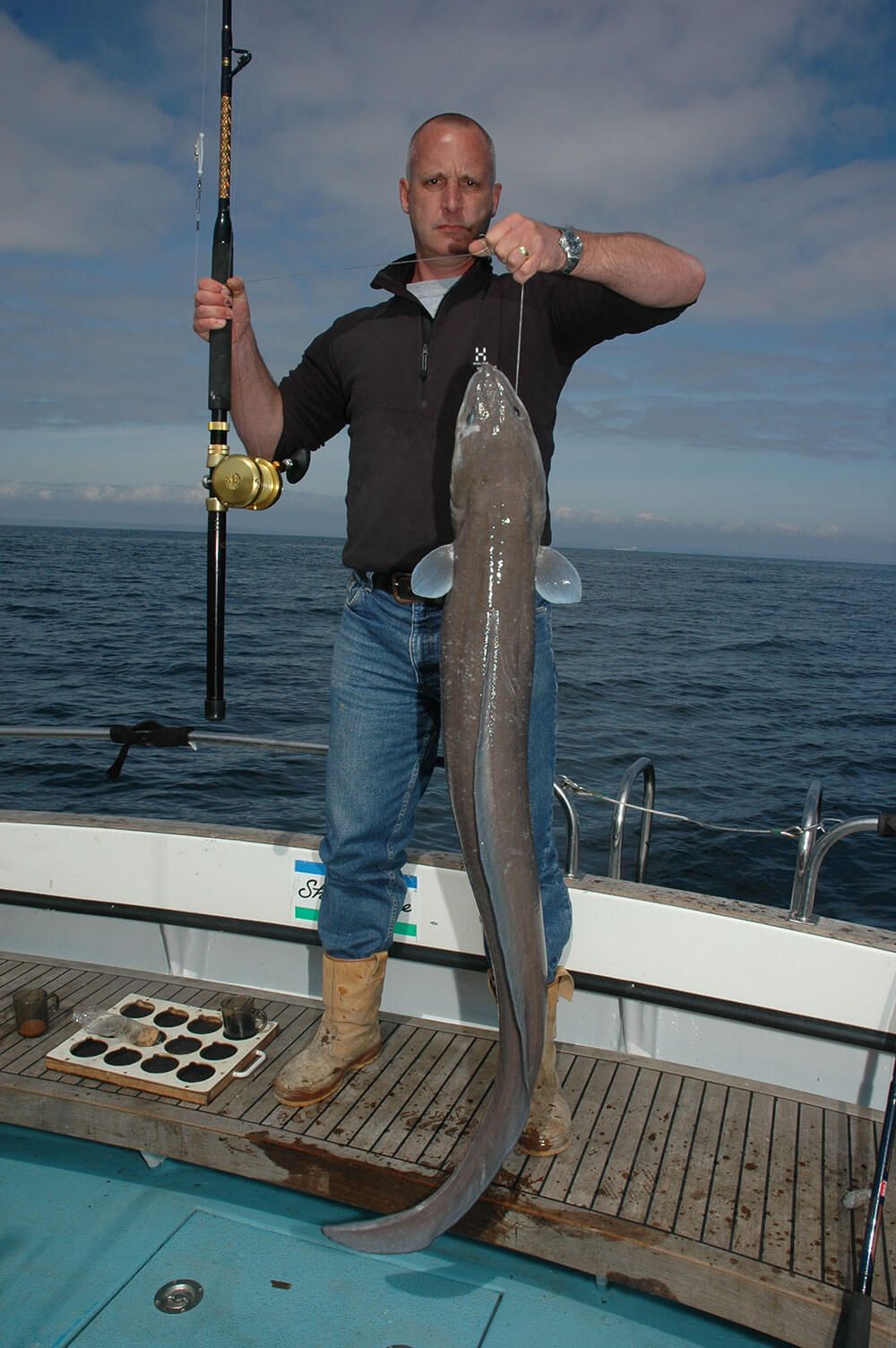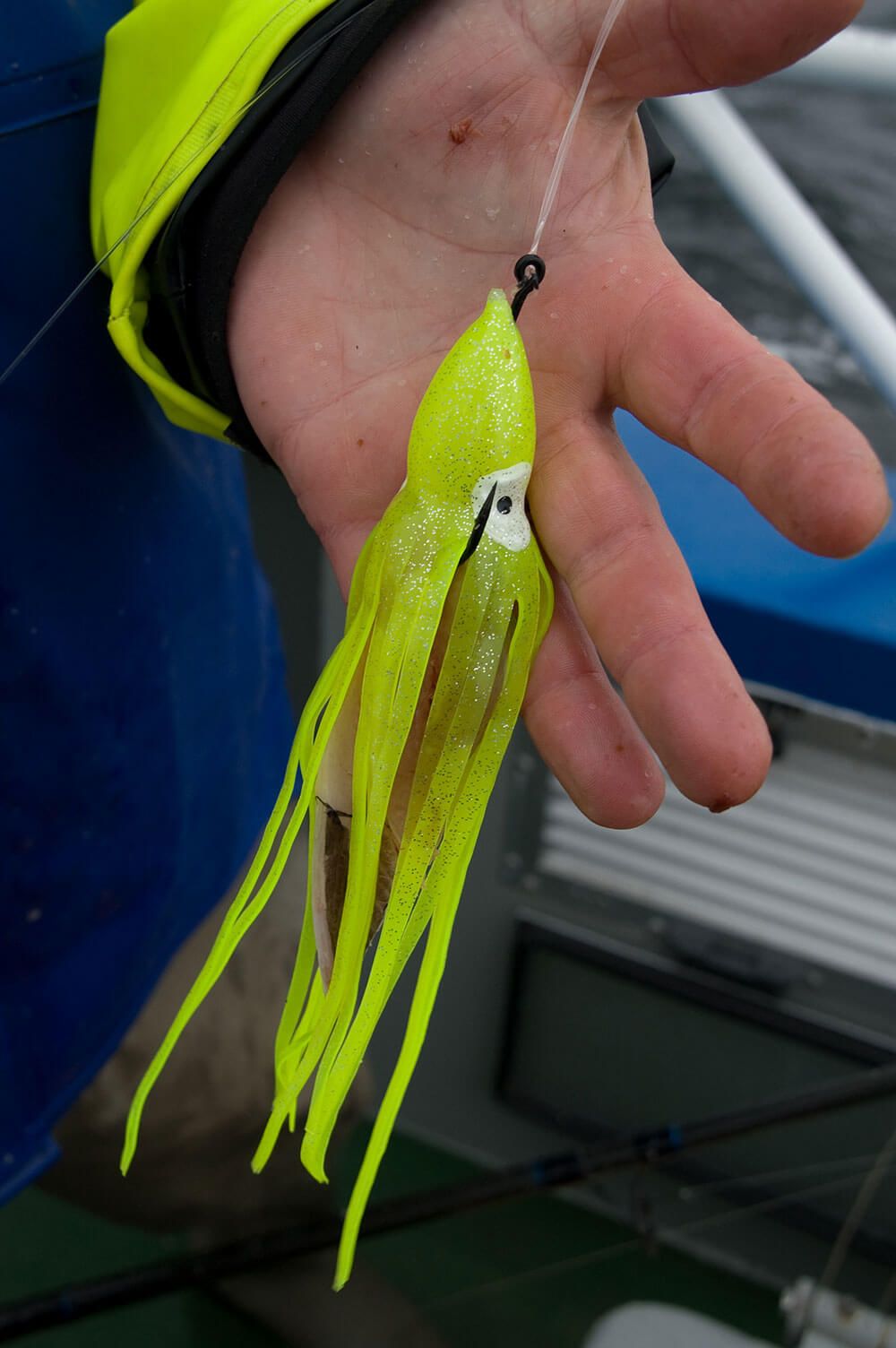Only the freshwater eel can be confused with the sea living conger eel, and when boat fishing this is a highly unlikely scenario. The difference between the conger and the freshwater eel is that the conger has a longer upper jaw and the river eel has a prominent lower jaw. The river eel also has rounded pectoral fins whereas the conger’s pectoral fins are pointed. Also on the conger the dorsal fin begins just rearwards of the pectoral fin, but on the river eel the dorsal begins half way back along the body.
The colouration of conger differs depending on what type of ground they are living over. On sand the conger will be a light to semi-dark brown, but in deeper water conger take on a light to dark grey colouring with a creamy brown to grey white belly colouring. Occasionally over reefs conger will be much darker like a slate grey.
Conger reputedly breed only once and congregate way out in the tropical Atlantic in depths as deep as 4000-metres. There seems to be no significant scientific information on whether conger have a definite breeding season. The larvae is flat and transparent and lives near the sea surface drifting slowly inwards towards continental Europe and transforming in to the recognised eel shape over a 1 to 2 year period.
Their adult diet consists of small fish such as pouting, poor cod, whiting, codling and small flatfish, also crabs, lobsters, squid and cuttlefish.

WHEN AND WHERE TO FISH
Conger populate the whole of the UK and Irish coastline, but are also found as far north as the southeast side of Iceland and southern Norway, also southward taking in the whole of the Mediterranean.
They are particularly predominant on the wrecks inside the English Channel, also from those in the Irish Sea and over rough ground off the Welsh and Scottish coast, also from the southern and west coast of Ireland. Without doubt, untapped conger fishing exists on the North Sea wrecks, and from the wrecks off the Northern Ireland coast.
They are available to anglers throughout the full twelve month period. There is no set time of year for a big conger, though many conger specialists prefer the warmer late summer period for the bigger fish, however many big conger have been caught either side of Christmas when angling pressure on the wrecks is least.
Conger choose to live in heavy rough ground close to shore and can often be found in surprisingly shallow water of just a few feet deep below the low water mark. In fact, on the biggest spring tides, small conger to 10lbs or so can sometimes be found hidden under rocks completely dry waiting for the tide to return.
The biggest conger are found living amongst the debris of deep water wrecks where their vast bodies can find holes and cracks within the structure to hide. They lay just with their heads at the mouth of their home, then pounce as unsuspecting food fish pass by.

On reef and wreck ground, conger tend to be fished for during the slack water period of neap tides, certainly the two hours either side of low and high water are the most quoted. This is good advice when fishing fast flowing, deep water, but on some wrecks the reverse is true. If the tide run is less strong overall, then modern anchoring techniques can be used during the bigger spring tides to position the boat and baits well above the wreck and the tide ride run be used to drift the smell back in to the wreck structure to lure the eels from their home and out in to clear ground where they can be fought easier.
CONGER TACKLE
On reef ground a 20 to 30lb outfit comprising something like a Penn TRQ100 or Shimano TLD 20/30 half loaded with mono and top shotted with the appropriate braid, then matched to a supple tipped but quickly stiffening middle action rod with a good stiff butt to give maximum leverage is the top choice.
For wreck fishing, the 30lb outfit is okay for average eels, but for the very big eels it’s necessary to choose a Penn TRQ200 loaded with 50 to 80lb braid, or the Shimano TLD 30 loaded with 50lb plus braid. Rods need to be a true 30/50 action such as the Penn Waveblaster 30/50 or the Shimano or other equivalent make.
HOW TO MAKE A BOAT CONGER EEL RIG
HOW TO MAKE A HALF FILLET MACKEREL BAIT
TOP TIP 1
Mono line is okay for shallower reef fishing, but in deeper water the sensitivity of braid gives you better information feedback through to the rod and hands as the eel eats the bait. Remember though that the eel will also feel line tension more and can spook easier, so a delicate touch by the angler is needed.
TOP TIP 2
Even huge eels can be shy biters. They often just “pluck” lightly on the rod tip as they gently inch the bait back in to their mouths. As you feel the eel pluck on the rod tip, allow just a couple of feet of free line to run off the reel which occurs as the eel accepts the bait and moves away. Strike only as the eel takes that free line then tightens against the rod tip.
TOP TIP 3
When the eel is hooked keep the pressure on and get the eel up in to more open water. It will then realise its in trouble and often powers back for the bottom. Give it line grudgingly as if it can it will make the safety of the reef or wreck and be lost. As an eel tires it will try and swim backwards rather than diving.
TOP TIP 4
When targeting conger it’s always worth having a second rod out with a luminous shrimp rig on baited with small strips of mackerel. This will catch pouting, poor cod and small whiting which the conger are naturally feeding on and these will often out fish fresh mackerel. Again fish them as either flappers or half fillet bodies with the hook in through the jaws.
TOP TIP 5
Squid and cuttlefish are also good baits for big wreck conger. When using squid, don’t position the hook in the body leaving the head and tentacles to dangle free. Conger are adept at chopping the tentacles off but leaving the squid body intact and avoiding the hook.
TOP TIP 6
Big eels also demand the use of a butt pad as they can apply massive pressure through the rod which the butt pad spreads and minimises. Some anglers advocate shoulder harnesses, but this is rarely necessary.
TOP TIP 7
If conger bites are hard to come by, try changing over to a lighter lead weight, just enough to hold bottom but light enough to drop back a few feet when the rod tip is lifted. Periodically inch the bait back towards you a few feet, then drop it back. This simple tactic can often induce a shy conger to take the bait.
TOP TIP 8
Just like ling, conger will also often take baits better if you slide a luminous yellow muppet over them. Conger are inquisitive and will home in on anything luminous, plus the movement of the muppet legs also excites the conger as the bait rolls in the tide.

TOP TIP 9
Conger are best unhooked using a T Bar. Simply slide the T Bar down the line and over the hook shank so it sits in the inner bend of the hook, pull the line down at a 90 degree angle to the fish and “bounce” the hook free using the natural weight of the fish. This does the eel no harm and will free even the most awkward of hooks.
TOP TIP 10
Conger fishing can be hectic with all the congers seeming to switch on to feeding at once. It pays to have at least a dozen traces ready made as you will lose too much fishing time trying to retie hooks on to traces and retackle up after a snapping out. Also making traces in the comfort at home means they are tied properly. When eels are coming in all around you, it’s far too easy to panic and create a weak trace that can cost you a big fish.
The colouration of conger differs depending on what type of ground they are living over. On sand the conger will be a light to semi-dark brown, but in deeper water conger take on a light to dark grey colouring with a creamy brown to grey white belly colouring. Occasionally over reefs conger will be much darker like a slate grey.
Conger reputedly breed only once and congregate way out in the tropical Atlantic in depths as deep as 4000-metres. There seems to be no significant scientific information on whether conger have a definite breeding season. The larvae is flat and transparent and lives near the sea surface drifting slowly inwards towards continental Europe and transforming in to the recognised eel shape over a 1 to 2 year period.
Their adult diet consists of small fish such as pouting, poor cod, whiting, codling and small flatfish, also crabs, lobsters, squid and cuttlefish.

WHEN AND WHERE TO FISH
Conger populate the whole of the UK and Irish coastline, but are also found as far north as the southeast side of Iceland and southern Norway, also southward taking in the whole of the Mediterranean.
They are particularly predominant on the wrecks inside the English Channel, also from those in the Irish Sea and over rough ground off the Welsh and Scottish coast, also from the southern and west coast of Ireland. Without doubt, untapped conger fishing exists on the North Sea wrecks, and from the wrecks off the Northern Ireland coast.
They are available to anglers throughout the full twelve month period. There is no set time of year for a big conger, though many conger specialists prefer the warmer late summer period for the bigger fish, however many big conger have been caught either side of Christmas when angling pressure on the wrecks is least.
Conger choose to live in heavy rough ground close to shore and can often be found in surprisingly shallow water of just a few feet deep below the low water mark. In fact, on the biggest spring tides, small conger to 10lbs or so can sometimes be found hidden under rocks completely dry waiting for the tide to return.
The biggest conger are found living amongst the debris of deep water wrecks where their vast bodies can find holes and cracks within the structure to hide. They lay just with their heads at the mouth of their home, then pounce as unsuspecting food fish pass by.

On reef and wreck ground, conger tend to be fished for during the slack water period of neap tides, certainly the two hours either side of low and high water are the most quoted. This is good advice when fishing fast flowing, deep water, but on some wrecks the reverse is true. If the tide run is less strong overall, then modern anchoring techniques can be used during the bigger spring tides to position the boat and baits well above the wreck and the tide ride run be used to drift the smell back in to the wreck structure to lure the eels from their home and out in to clear ground where they can be fought easier.
CONGER TACKLE
On reef ground a 20 to 30lb outfit comprising something like a Penn TRQ100 or Shimano TLD 20/30 half loaded with mono and top shotted with the appropriate braid, then matched to a supple tipped but quickly stiffening middle action rod with a good stiff butt to give maximum leverage is the top choice.
For wreck fishing, the 30lb outfit is okay for average eels, but for the very big eels it’s necessary to choose a Penn TRQ200 loaded with 50 to 80lb braid, or the Shimano TLD 30 loaded with 50lb plus braid. Rods need to be a true 30/50 action such as the Penn Waveblaster 30/50 or the Shimano or other equivalent make.
HOW TO MAKE A BOAT CONGER EEL RIG
HOW TO MAKE A HALF FILLET MACKEREL BAIT
TOP TIP 1
Mono line is okay for shallower reef fishing, but in deeper water the sensitivity of braid gives you better information feedback through to the rod and hands as the eel eats the bait. Remember though that the eel will also feel line tension more and can spook easier, so a delicate touch by the angler is needed.
TOP TIP 2
Even huge eels can be shy biters. They often just “pluck” lightly on the rod tip as they gently inch the bait back in to their mouths. As you feel the eel pluck on the rod tip, allow just a couple of feet of free line to run off the reel which occurs as the eel accepts the bait and moves away. Strike only as the eel takes that free line then tightens against the rod tip.
TOP TIP 3
When the eel is hooked keep the pressure on and get the eel up in to more open water. It will then realise its in trouble and often powers back for the bottom. Give it line grudgingly as if it can it will make the safety of the reef or wreck and be lost. As an eel tires it will try and swim backwards rather than diving.
TOP TIP 4
When targeting conger it’s always worth having a second rod out with a luminous shrimp rig on baited with small strips of mackerel. This will catch pouting, poor cod and small whiting which the conger are naturally feeding on and these will often out fish fresh mackerel. Again fish them as either flappers or half fillet bodies with the hook in through the jaws.
TOP TIP 5
Squid and cuttlefish are also good baits for big wreck conger. When using squid, don’t position the hook in the body leaving the head and tentacles to dangle free. Conger are adept at chopping the tentacles off but leaving the squid body intact and avoiding the hook.
TOP TIP 6
Big eels also demand the use of a butt pad as they can apply massive pressure through the rod which the butt pad spreads and minimises. Some anglers advocate shoulder harnesses, but this is rarely necessary.
TOP TIP 7
If conger bites are hard to come by, try changing over to a lighter lead weight, just enough to hold bottom but light enough to drop back a few feet when the rod tip is lifted. Periodically inch the bait back towards you a few feet, then drop it back. This simple tactic can often induce a shy conger to take the bait.
TOP TIP 8
Just like ling, conger will also often take baits better if you slide a luminous yellow muppet over them. Conger are inquisitive and will home in on anything luminous, plus the movement of the muppet legs also excites the conger as the bait rolls in the tide.

TOP TIP 9
Conger are best unhooked using a T Bar. Simply slide the T Bar down the line and over the hook shank so it sits in the inner bend of the hook, pull the line down at a 90 degree angle to the fish and “bounce” the hook free using the natural weight of the fish. This does the eel no harm and will free even the most awkward of hooks.
TOP TIP 10
Conger fishing can be hectic with all the congers seeming to switch on to feeding at once. It pays to have at least a dozen traces ready made as you will lose too much fishing time trying to retie hooks on to traces and retackle up after a snapping out. Also making traces in the comfort at home means they are tied properly. When eels are coming in all around you, it’s far too easy to panic and create a weak trace that can cost you a big fish.

